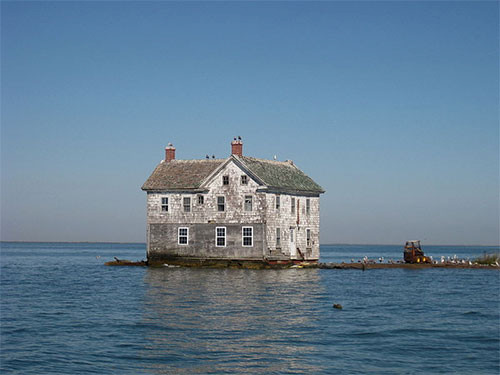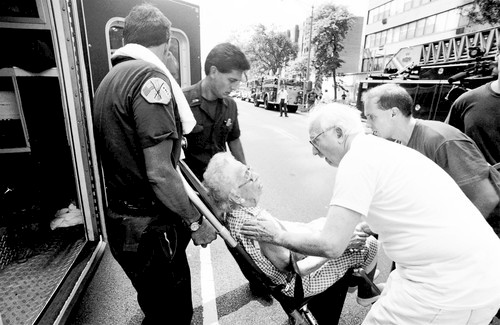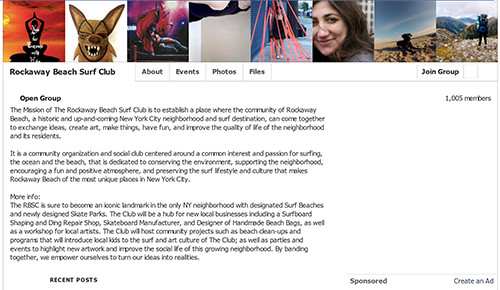Resilience of Coastal Communities Depends on Maintaining Social Infrastructure
Bill Nuttle ·Hurricane Sandy was a wake-up call. More and more, people are asking, "What can be done to sustain coastal communities in the face of climate change and accelerated sea level rise?" The story of Holland Island, a once-thriving fishing community, reveals the importance of maintaining social infrastructure to sustain communities.

Coastal communities must be resilient to cope with changing conditions served up by a sometimes harsh environment. In ecology, resilience is a community’s ability to limit damage and recover quickly from a disturbance such as a hurricane. Resilience has structural and functional aspects. Both the physical infrastructure of a community and the structure of its institutions contribute to resilience by limiting damage and disruption. Resilience also depends on a community’s ability to remain functioning during the disturbance and recover afterward. Effective community response in the immediate aftermath of a hurricane, such as locating missing people and distributing food and supplies, depends on both official institutions, like the police and rescue units, and on the informal social connections that exist from before the storm.
Discussions around climate-proofing coastal communities usually focus on strategies to limit damage from coastal storms. Basically, there are three strategies for coping with the impact of natural hazards: avoid, reduce, and absorb. Avoidance strategies include measures such as fortifying facilities with flood walls or protecting large areas of the coast behind permanent dikes and mobile surge barriers. Reduction strategies involve beefing up drainage systems, relocating critical equipment out of basements and onto the roofs of buildings, and redesigning power grids and communications systems to limit the consequences of broken connections. The strategy of acceptance, which the Dutch call “making room for water”, involves measures such as designating parks and playing fields as flood zones and constructing buildings that are able to stay dry by floating on flood waters. These strategies address the structural the structural aspects of resilience.
Work by sociologist Eric Klinenberg points to the importance of the informal social connections involved in the functional aspect of resilience. Klinenberg’s investigation of community response to a heat wave that hit Chicago in 1995 revealed the importance of social connectedness within communities to resilience (Klinenberg 2002). The 1995 Chicago heat wave was an extreme event that led to approximately 750 heat-related deaths over five days. Death rates varied by neighborhood within the city. As expected, wealth was a factor in explaining this variation, but it was not the only one. The wealthy could afford air conditioning to protect themselves from the direct impact of the heat, and they had means to escape the city. However, neighborhoods with the lowest death rates included several of the city’s poorest. When Klinenberg looked for factors to explain differences in the death rate among the poorest neighborhoods, he found that neighborhoods with a greater degree of connectedness among residents, as indicated by a more active street life for example, did much better than neighborhoods in which residents were more isolated from each other. Greater social connectedness within a community decreased the possibility that anyone would succumb isolated and helpless from the physiological effects of the heat.

Klinenberg found informal social connections playing a similar role in the recovery from disturbance when he visited communities devastated by Hurricane Sandy in October 2012 (Klinenberg 2013). For example, founders of the Rockaway Beach Surf Club transformed themselves into a temporary relief agency. With no power in the area and phone service down, they broadcasted an appeal to the community via Facebook that brought 5000 volunteers to help. Major disturbances, like hurricanes, disrupt communication and transportation infrastructure that structured organizations such as fire departments, the police, and government agencies rely on to operate under normal circumstances. In this situation people fall back on the informal, social relationships to maintain essential functions.

The story of the community of Holland Island shows how important social infrastructure can be. Holland Island, in Chesapeake Bay, was home to a fishing community established in 1855. In 1910, the community had grown to a thriving village of 360 people with its own school, post office, and several other community buildings. But by 1918, nearly everyone had abandoned the island, disassembling and taking most of the buildings with them. Environmental factors contributed; erosion related to rising sea level was a problem. However, it was the breakdown in the social functioning of the community that triggered the decision of residents to leave (Gibbons and Nichols 2006). The last structure on Holland Island, a two-story house, resisted the slow assault of rising sea level for nearly a century after people had gone.

